



























cycle THE MAGAZINE OF CYCLING UK On test DECEMBER 2022/JANUARY 2023 Plus ROADIE MUDGUARDS VELOBIN PANNIER SINEWAVE BEACON 2 FROG MTB 69 & MORE CYCLE-CAMPING ACROSS NAMIBIA Page 32 CONTINENTAL DRIFTER Long-distance European touring NO WAY! What’s wrong with Wainwright’s C2C REIVERS ROUTE RIDE GUIDE THE BEST LIGHTS FOR YOUR RIDING EUROPE’S HIGHEST ROAD CLIMB AND MUCH MORE AFRICAN ADVENTURE BUDGET E-CARGO BIKES CAR REPLACEMENTS FOR UNDER £2,000







MEMBERSHIP FROM JUST £3. 88 A MONTH!* CLICK HERE FOR MORE INFORMATION *See www.cyclinguk.org/join for more information and for terms and conditions. MEMBERSHIP FROM JUST £3. 88 A MONTH!* CLICK HERE FOR MORE INFORMATION
There’s no such thing as bad weather, only bikes without decent mudguards. Rambler Alfred Wainwright may have cautioned against unsuitable clothing but for cyclists it’s the mudguards that really matter. Without them, damp winter rides – especially winter group rides – are a like sitting beside a dirty-water lawn sprinkler.



So why do so many road cyclists go without? I was thinking about this towards the end of an autumn century ride, when the heavens opened and the unprotected back wheel I was then sitting behind started spraying like a potter’s wheel. My first thought: this is ridiculous.

My second thought: the industry is selling the dream of inappropriately impractical bikes to people who subsequently invest too much cash in them to admit they’ve bought the wrong bike for year-round riding on a soggy island in the north Atlantic.
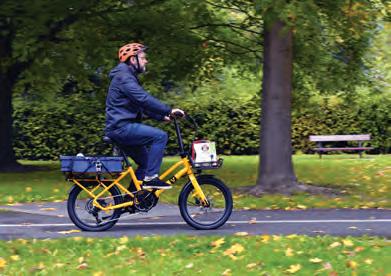


Maybe that’s where the denialism gets in. “If this bike, which the cycling media tells me climbs like a mountain goat, corners like a cheetah wearing ice skates, and is absolutely worth four and a half stars, will not take mudguards, well, mudguards are unnecessary, QED.”
Fortunately there are workarounds. Not those little flaps that fit under the saddle to stop a soggy bum, but reasonably long mudguards designed to make road bikes wet-ride ready. We’ve tested four sets this issue – see page 69. I can think of a few riders who need to read this right now. How about you?

 DAN JOYCE Cycle Editor
DAN JOYCE Cycle Editor
Founded in 1878
60 38 73 32
CONTENTS On the cover Camping in the Namib Desert by Nicolás Marino/ Alamy
Welcome
FEATURES 32 Desert crossing Thirsty for adventure
Damaraland 38 Continental drifter Long-distance
different
Brexit 47 No way! Fighting against cyclists’ exclusion from our newest national trail PRODUCTS 18 Shop Window Christmas gift ideas that are useful, not tat 20 Gear up Components, accessories, and books 60 Budget e-cargo bikes Longtail load-haulers for less than £2,000 66 Frog MTB 69 A high-performance junior hardtail 69 Road bike mudguards No eyelets? No clearance? No problem REGULARS 04 Freewheeling Bits and pieces from the bike world 07 This is Cycling UK Making cycling e-asier update; stalemate at Stormont; 100 Women in Cycling 2022; supporting the Cyclists’ Defence Fund 16 You are Cycling UK The travels of cancer survivor Candy Whittome 29 Letters Your feedback on Cycle and cycling 44 Weekender The 170-mile Reivers Route across northern England 54 Cyclopedia Questions answered, topics explained 73 Travellers’ Tales Cycling UK members’ ride reports Top to bottom: Keir Gallagher, Steve Melia, Richard Peace, Jane John CYCLING UK: Parklands, Railton Road, Guildford, GU2 9JX E: cycling@cyclinguk.org W: cyclinguk.org T: 01483 238300. Cycle promotes the work of Cycling UK. Cycle’s circulation is approx. 51,000. Cycling UK is one of the UK’s largest cycling membership organisations, with approx. 70,500 members and affiliates. President: Jon Snow Chief Executive: Sarah Mitchell. Cyclists’ Touring Club, a Company Limited by Guarantee, registered in England No 25185, registered as a charity in England and Wales Charity No 1147607 and in Scotland No SC042541. Registered office: Parklands, Railton Road, Guildford, GU2 9JX. CYCLE MAGAZINE: Editor: Dan Joyce E: editor@cyclinguk.org Designer: Christina Richmond Advertising: Elly Kiss T: 0203 198 3092 E: elly.kiss@jamespembrokemedia.co.uk Publisher: James Houston. Cycle is published six times per year on behalf of Cycling UK by James Pembroke Media, 90 Walcot Street, Bath, BA1 5BG. T: 01225 337777. Cycle is copyright Cycling UK, James Pembroke Media, and individual contributors. Reproduction in whole or in part without permission from Cycling UK and James Pembroke Media is forbidden. Views expressed in the magazine are those of the individual contributors and do not necessarily reflect those of the editor or the policies of Cycling UK. Advertising bookings are subject to availability, the terms and conditions of James Pembroke Media, and final approval by Cycling UK. Printed by: William Gibbons & Sons Ltd, 26 Planetary Road, Willenhall, West Midlands, WV13 3XB T: 01902 730011 F: 01902 865835
in Namibia’s
European touring is
since
DONATE NOW FOR TOMORROW’S JUSTICE
An awful lot has happened in the last year. It seems like only yesterday we were celebrating victory in Shoreham and showing councils across the country that there are serious repercussions for unlawfully removing cycle lanes. That win was down to you, thanks to your support and generous donations.
This year we fought to ensure justice prevailed again, this time for Tom Bosanquet. When Avon and Somerset police made the decision to charge Tom for inconsiderate cycling, he contacted us. Through our Cyclists’ Defence Fund, we paid his legal costs for defending the case. We felt it was only right to support Tom, one of our members, not only to help him but also to ensure decisions like this don’t happen again.
Tom had found himself at the traffic lights next to a driver who was engrossed in using a mobile phone, and then witnessed another
running through a red light. Tom submitted video evidence of these offences, only to be prosecuted himself for inconsiderate cycling because he’d delayed another driver for a few seconds!
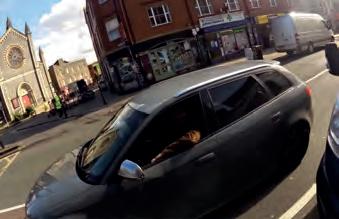
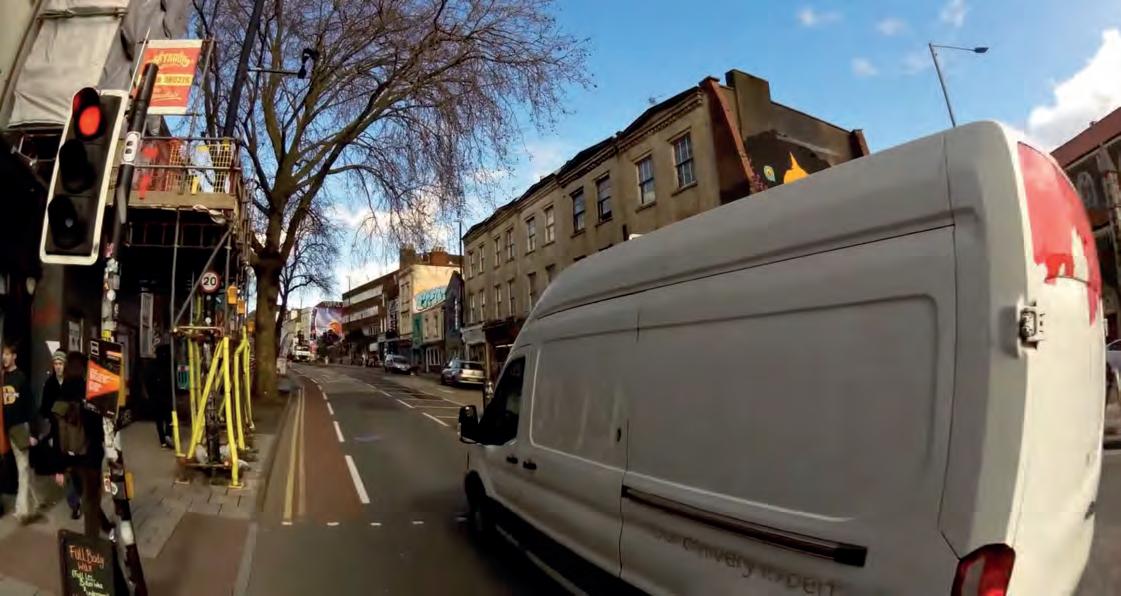
The Crown Prosecution Service saw sense when it reviewed the case before the trial date, and rightly took the decision to drop it. Prosecuting a cyclist for delaying a motorist risked setting
a dangerous precedent, potentially leading to cyclists being blamed for other people’s impatience or bad driving. That was why the Cyclists’ Defence Fund took Tom’s case. Yet Tom’s experience isn’t unique. A police officer in Essex this year stopped two cyclists he claimed were “causing an obstruction” and “causing people to drive carelessly” – a complete misrepresentation of the Highway Code.
Off-road access
It is not just on our roads where we are having to use our Cyclists’ Defence Fund to ensure that cyclists’ rights are heard.
We were delighted to hear the announcement of a new national trail, the coast-to-coast Wainwright route, stretching from St Bees in Cumbria to Robin Hood’s Bay in North Yorkshire. But much to our dismay it was designed to be inaccessible to cyclists – and, for that matter,
this is
Caught running a red light: not charged. The cyclist filming was!
14 cycle DECEMBER 2022 / JANUARY 2023
stills:
Video
Tom Bosanquet
The fight for justice for cyclists never stops and we need your help. Please donate now at cyclinguk.org/cdf
appeal
Christmas
Only two of England’s 16 National Trails are ridable. Donate now to change this!
we set to work.
National trails can be planned as multiuser trails (see p47), but currently just two of England’s 16 existing national trails have been. The Wainwright route was to be for walkers only, too. Natural England and DEFRA failed to consult with Cycling UK and the BHS during the initial consultation phase of the new national trail. This is despite both organisations being prescribed outdoor user groups, who should be consulted on changes to rights of way.
On this basis, our only course of action was to submit a Pre-Action Protocol letter to the then Secretary of State for the Department for Environment, Food and Rural Affairs (DEFRA), the Rt Hon Ranil Jayawardena MP. That letter set out the legal grounds and demonstrated the ways in which the decision was unlawful. It called on the government to reconsider the proposals for the route because Natural England had failed to consult appropriately.
Thanks to our joint threat of legal action, DEFRA and Natural England have undertaken to consult with ourselves and BHS and revisit their decision. The best possible outcome from this would be that the Wainwright route is made accessible for people cycling and horse riding as well as on foot.

More cycle lanes, not fewer

This year cycle lanes and judicial reviews have been at the forefront of our minds once again. A long-awaited report that the Royal Borough of Kensington and Chelsea commissioned from the Centre for London was finally published. It recommended that more cycle lanes were needed – timely advice because there’s a judicial review of the decision the borough took to remove a cycle lane on Kensington High Street. This is scheduled for trial in December.
While the judicial review is being brought by Better Streets for Kensington and Chelsea, we chose to use CDF resources to support them. By providing advice and financial support to another superb local group, we can further the reach of the fund and our work.
We all know it can take time to effect change. Take the Highway Code: years of campaigning and hard work finally saw a significant revision. Thanks again for supporting us through that.
Déjà vu on Dartmoor

Our next big challenge – and one reason we need your donations now – will likely be fighting for cycling access on Dartmoor. Some 24 years ago we staged a protest on Dartmoor against bye-laws that restricted cycling there. We could be heading back there…












We’re looking at Dartmoor’s bye-laws now because last year the Dartmoor National Park Authority (DNPA) consulted again on them. We believe that the criminalisation of cycling across large parts of Dartmoor conflicts with the statutory purposes of national parks. DNPA is about to publish its final proposals for bye-law amendments. If the restrictions aren’t relaxed, that’s another challenge to consider – and another protest!

Like many of the cases we pursue, the Dartmoor one could set a dangerous precedent so we want to nip it in the bud. There’s a worrying trend for authorities trying to restrict cycling access –despite an upsurge in cycling from people looking for economical and ecological ways to travel, and for safe and stunning places to ride their bikes.
That is what we want for all cyclists and would-be cyclists. With your help and donations, we can achieve this. So please, at this festive time, give a donation to the Cyclists’ Defence Fund. Thank you.
• ONLINE: at cyclinguk.org/cdf
• PHONE: by calling 01483 238 300
• POST: send a cheque made payable to ‘Cycling UK’ to: Cycling UK, Parklands, Railton Road, Guildford, SURREY GU2 9JX , not forgetting to let us know it’s for the Cyclists’ Defence Fund.
CYCLINGUK.ORG cycle 15
Ennerdale – donate now to ensure you get to see this view by bike. The protected cycle lane in Shoreham that was unlawfully removed. Cycling UK’s 1998 protest on Dartmoor
Clockwise from top: alh1, FlickrCC; Shoreham ByCycle; Alec McCalden
horse riders. In conjunction with The British Horse Society,
DONATE NOW TO THE CYCLISTS’ DEFENCE FUND
Great Rides
On a meandering tour from Kenya to Cape Town, Keir Gallagher and his partner Heba spent a week riding through Damaraland in Namibia



DESERT CROSSING
Giraffe numbers are on the rise here but (right) the human population is sparse
KEIR GALLAGHER

Keir and Heba are on a year-long tour. Follow them on Instagram @boosting_about
Cycling into a desert is always a daunting prospect. We’d mapped out a chain of water points, increased our capacity to 23 litres between the two of us, and crammed our panniers with seven days’ worth of breakfasts, lunches, dinners and snacks. Yet as we rolled out of the frontier town of Kamanjab and into Damaraland, a sparsely populated and desperately arid region of the Namib Desert, our excitement was tempered by nervousness.
Would the wells we were relying on be dry? Would our supplies last? And, perhaps just as importantly, would the scenic wonders of this inhospitable region live up to our high expectations?


ARID BEAUTY
As it turned out, that last question was first to be answered. We’d spent the previous weeks of our tour from Kenya to Cape Town cycling and hitchhiking across the Kalahari savanna, our minds numb after 2,000 kilometres of dead-straight, pan-flat roads. I was anticipating a day or two of transition from the dull plains to the unique scenery of the Namib Desert.


But from the moment we left town, we found ourselves riding through a rapidly changing landscape. A natural sculpture park of Picassoesque boulders rose from either side of the road, carved by millennia of wind, while jagged crags burst upwards between them like shards of glass.
Thrilled by the scenery, our first real challenge was soon visible ahead: Grootberg Pass, a snaking line of gravel weaving between the cliff-crowned, flat-topped Palmwag mountains. At just 350m in altitude, it ought to have been an uncomplicated climb, but in Namibia nothing is as straightforward as it ought to be.
As we began the approach, one of my overladen panniers became the first casualty of the rough roads: a screw had rattled loose and disappeared in the sand, leaving the bag hanging limply off the
rack. I pinched another to patch it up, and we were soon beginning the climb, hauling our 60kg bikes into a fierce headwind under the blistering sun.
It was a tiresome slog, but with stunning scenery on all sides, glowing golden in the afternoon light, it was impossible to be anything but elated as we summited the pass and rolled down to find a beautiful spot to camp. A magnificent starscape soon grew above us.
NAMIBIA GREAT RIDES CYCLINGUK.ORG cycle 33
Contine


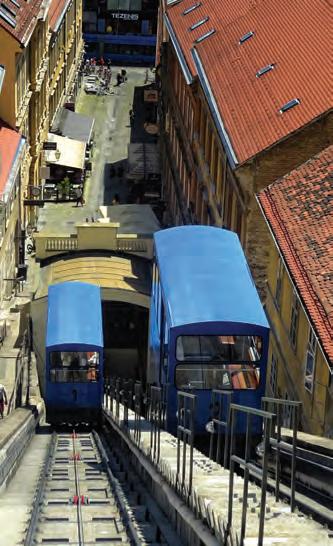
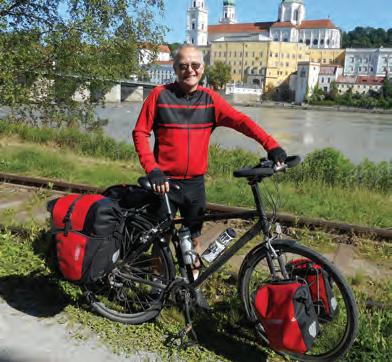

Clockwise from top left: Stein am Rhein, Switzerland. Rijeka, Croatia. Steve near Passau, Germany. Little Venice in Colmar, France. Zagreb funicular, Croatia

GREAT RIDES EUROPE
drifter ntal
Brexit wasn’t going to stop Steve Melia’s long-anticipated, extended tour across Europe and back – but it would make it more complicated Healthcare
& insurance
When I retired, I promised myself I’d take a long tour through Europe. All my holidays have been in Britain or Western Europe for the past 17 years, as I stopped flying when I started working in sustainable transport. With time on my hands, I could dream of going further. By March 2022, two months before my 60th birthday, I was ready.
The idea was to ride through France, meeting up with some old friends and my father, who lives there, and then follow Eurovelo Route 6 to Vienna. From Vienna I would turn south, following Routes 9 and 8 along the Adriatic coast to Greece, before taking the ferry to southern Italy to start the long ride home.
I began planning all this before Brexit, however. The new rules have complicated travel across Europe and, as I would discover, unexpected events can complicate them still further. Due to the 90-day Schengen limit (see ‘The clock is ticking’, p41) my route was designed to reach Croatia as soon as possible. The sooner I could cross the Croatian border, the more time I could spend in Greece at the end of the trip. Or so I thought.
The weight I was carrying would limit my daily mileage but that was fine; I wanted to spend time enjoying the experience. Some of my cycling friends couldn’t understand why I wanted to carry so much stuff, but washing a single pair of underpants every night for several months is not my idea of fun.
FIRST STOP: FRANCE
I bought a pair of giant 70-litre Ortlieb panniers for the rear and a 25-litre pair for the front. I was going to take emergency camping gear but the bike was already too heavy, so I took my chances on finding affordable accommodation. For all their faults, Airbnb and booking.com have made that easier. I also used warmshowers.org, a community of cyclists offering accommodation free of charge,
through Britain and France, but it became more difficult to find hosts after that and I eventually stopped trying.
I crossed the Channel from Poole to Saint-Malo to ride through familiar territory, although it had been three Covid-infected years since my last visit to France; the remaining Covid restrictions there were lifted a few days after my arrival. I had almost forgotten what a great country France is to ride through, with its dense network of quiet lanes.
From Rennes, I headed south-east towards the Loire, where I followed Eurovelo 6 for a few days before turning south. This was the famous chateau route at its springtime best. In Saumur I spent a night in a studio flat inside a medieval building, where I carried my bike up a spiral staircase that looked like the entrance to a dungeon.
As I left the Loire corridor to follow the Vienne south-east, the population density began to fall. I have passed through many quiet villages in France but the contrast was particularly stark here.
Sylvain, an old friend from Paris, planned to join me in Argenton-sur-Creuse, from where we would ride together for two days. He has helped me out many times over the years – and soon would again.
The day from Argenton to Guéret was tough. The ride from Saint-Malo had been fairly flat, but as the terrain turned hillier the heavens opened. The 80km ride was long enough for me with full panniers; Sylvain had not ridden a bike since the pandemic and found it harder. In the only town on the route, Dun-le-Palestel, everything was closed, including the big supermarket. As we ate peanuts and muesli under the canopy of its petrol station, my body temperature dropped to shivering point.
The following day the weather improved as we followed the River Creuse to Aubusson. The beauty of the valley reminded me why my father chose to retire here, though he sometimes found it too quiet. Like much of rural France, the bars close early and
Brexit actually made little difference to healthcare for travellers. The GHIC has replaced the old E111, and in theory provides similar benefits. My experience is only in France (and nothing very serious) but whenever I have tried to use either of those cards, the receptionists or practice managers have always said: “I have no idea what that is; you will have to pay the full amount.” So the bottom line is, if you travel, you need healthcare insurance. It will not cover everything. No travel insurance would have covered the complicated dental treatment I needed.
For trips longer than 120 days, I discovered that it is almost impossible to insure your bike. I could have added it to the ‘gold level’ sports travel insurance I took out, but the additional premium would have been more than the bike was worth. Fortunately, the thieves who stole my phone and camera didn’t take the bike!
CYCLINGUK.ORG cycle 39 EUROPE GREAT RIDES
CYCLOPEDIA
Knowhow

Making sense of commonly misunderstood subjects

Dan is glad that EveryReady lights with D-cells are long gone

Lighting What lights do I need?

The best choice of lights for seeing and being seen while cycling at night will depend on how and where you ride.







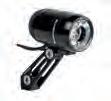



UNDER STREETLIGHTS
The primary role of your lights here is to make you conspicuous; you don’t need a strong beam. Flashing or pulsing lights work well under streetlights. Other road users can still track your position thanks to the streetlights, and they’re more likely to notice you initially.

Since traffic will be travelling slower – e.g. 30mph – being seen from a huge distance away isn’t vital. But there will be junctions so it’s important that your lights are visible through a wide arc front and rear, not just directly in front or behind. Dynamo lights need a standlight as you’ll likely be stopping and starting often.
UNLIT ROADS

Without streetlights, your front lamp must have a beam powerful enough to light the way further ahead than your riding speed’s stopping distance. Avoid the temptation to fit a mountain biking light that will dazzle other road users. A road-specific light with a focused beam and around 300-500 lumens should be sufficient. If
you want brighter, look for a beam cut-off at the top of the lens and/or the facility to switch to a lower output to instantly ‘dip your headlight’. The rear light needs to be bright enough to be seen from far behind as traffic may be travelling fast. Look for 30-50 lumens or more. Avoid using a flashing rear light unless you also use a steady one. A flasher won’t signpost your trajectory or proximity in the dark.

OFF-ROAD TRAILS

Mountain biking at night requires lots of lumens. Most dynamo setups won’t produce enough – although the Sinewave Beacon 2 (p20) and Exposure Revo may, depending on your riding. As a rule of thumb, you’ll want at least 800 lumens from your main light. More is better. A broader beam that gives you peripheral vision is helpful, as is a secondary light with a tighter-focused spot on your helmet. For the rear light, saddle rail mounting is useful as it doesn’t preclude a dropper seatpost.
Lighting law
To ride on the road legally between sunset and sunrise, your bike (not you) must be fitted with an approved white front light and an approved red rear light. (You also need a red rear reflector and amber pedal reflectors.) Lights that can only flash –hardly any – must emit at least 4 candela (~50 lumens). Lights that have a steady mode must be marked as conforming to BS6102/3 or an equivalent EC standard. In practice, it’s difficult to find approved lights in the shops… unless you run dynamo lights, which usually meet the German StVZO standard. A small number of battery lights also do and are marked as such. Having said that, you won’t be stopped by the police as long as you fit bright lights of the correct colour that don’t dazzle. cyclinguk.org/lightingregulations
Front:
Front:
Front:
58 cycle DECEMBER 2022/JANUARY 2023
DAN JOYCE Editor
Shining examples A short list of good lights. Exposure Trace & Tracer Mk2 Daybright set, £85. exposureuse.com Under streetlights (battery) Under streetlights (dynamo) Unlit roads (battery) Unlit roads (dynamo) Off-road trails
Busch & Müller Avy T Senso Plus, £50. Rear: B&M Flat S LineTec Plus, £25. ambadistribution.com
Front:
Ravemen
bob-elliot.co.uk.
Lezyne Strip Drive Pro 300, £52. upgradebikes.co.uk
PR1600, £139.99.
Rear:
Supernova E3
2, £200. Rear: Supernova E3 Rear
Light 2, £60.
Pro
Dynamo
ambadistribution.com
MagicShine Monteer 3500, £190. magicshineuk.com Rear: CatEye Rapid Micro, £19.99, plus RM1 bracket, £9.99. cateyecycling.co.uk
Photo: Robert Spanring




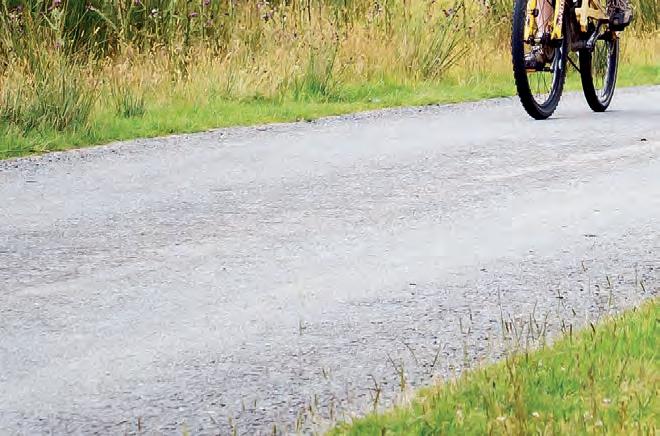

CLICK HERE FORMOREINFORMATION MEMBERSHIP FROM JUST £3. 88 A MONTH!*
First look
Biketest


Budget e-cargo bikes
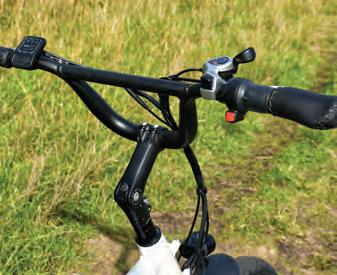
An e-cargo bike is a viable alternative to a car for heavily laden journeys. Richard Peace tests models from Mycle and Velosta that cost less than £2,000
Conventional bikes and e-bikes can tackle many single-occupant car journeys, as any cyclist knows. Add a trailer and they can haul the weekly shop or a couple of pre-school passengers as well. E-cargo bikes go further. They can easily transport bigger, heavier loads and more and/or bigger passengers than is possible or practical by bike and trailer. Those journeys that people say you have to have a car for? An e-cargo bike can do lots of them.
The downside of e-cargo bikes, despite their low running costs, is that the initial purchase price can be high. Several thousand pounds isn’t uncommon. We’ve looked at some of them before, such as the excellent Tern GSD (cyclinguk.org/cycle-magazine/ bike-test-tern-gsd-s10-electric-cargo-bike). For this test, I’m focusing on e-cargo bikes that cost less than £2,000 – mid-priced for an e-bike, very much budget priced for an e-cargo bike.
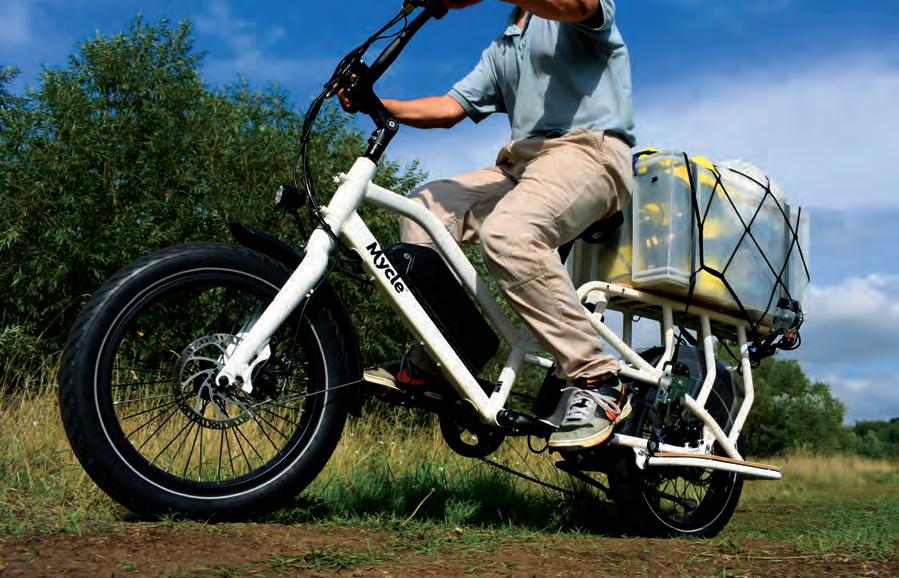
Both featured models, the Mycle Cargo and the Velosta V1, have the benefit of coming from UK-based
companies who can provide help at the end of a phone. So there is extra value in that budget price too, compared to buying blind from an anonymous web discounter. The test bikes’ contrasting sizes and carrying capacities have their own particular pros and cons, but that means that even at the low end of the e-cargo price scale there is real choice.
Frame and fork
Both bikes are longtails: the extra carrying capacity comes from an extra-long, superstrong pannier rack that’s welded into the rear structure. This long rack can be fitted with various carrying accessories such as cargo boxes and child seats. The rear loading area is considerably bigger on the Mycle: I fitted a tall, 70cm-long carrying box on top (with ratchet straps) but was limited to a low-profile 60cm box on the
60 cycle DECEMBER 2022 / JANUARY 2023
BIKE TEST E-CARGO BIKES
Suits heavier loads best thanks to a high-torque rear hub motor and a big 720Wh battery
RICHARD PEACE Richard is a cycling journalist and author. His books include Electric Bicycles and The Ultimate C2C Guide
Velosta. As well as having a shorter rack, the Velosta’s seat overhangs more of it.
Both bikes are built from large gauge aluminium tubing with a sloping down tube for easy stepover mounting. And both have a very strong, latticestyle frame at the rear to give strength to the main load-bearing area. The Mycle has space just behind the seat tube to accommodate an optional second battery, potentially doubling your range. The Mycle also comes with composite, imitation plywood boarding for the rack-top and footrests. The Velosta, meanwhile, can be stored vertically as it can be balanced on the rear of the frame.
Like most longtails, both bikes use 20in wheels. The loading space above the rear wheel is thus relatively low down and stable. The frames have clearance for large volume tyres, which help spread the load – super-plush 3in-wide ones on the Mycle and 2.35in tyres on the Velosta. As both models have rigid aluminium forks, they rely on their large-volume tyres and comfy seats to cushion the ride.
Bike weights reflect the relative sizes of the frames and their (proportionately sized) electric-assist systems. The Velosta weighs in at an impressively light 21.5kg, while the Mycle is significantly heavier at 33.1kg. Total payload limits (rider plus cargo) are 140kg and 215kg respectively.
Components
The ‘little and large' differences are reflected in the electric assistance offered. The Mycle has a potent-looking Bafang rear hub motor with a ‘fat bike’ spec of 48 volts, rated at 65Nm of torque.
It’s powered by a 720Wh battery with high-quality LG 21700 cells, some of the most energy dense on the market, and they're from a maker with a premium name.
By contrast the Velosta uses the bijou Bafang G310 36-volt, 45Nm rear hub motor – one that I’ve come across a few times and really rate. (What looks like a bottom bracket motor is in fact the battery.) It’s clearly tailored to the more modest weight and payload rating of the bike. The 345Wh battery and smaller motor might


Tech Spec MYCLE CARGO
Price: £1,999 (inc delivery).
Sizes: one size. Weight: 33.1kg/ 72.8lb (base model).
Frame & fork: 6061 aluminium with integral rear rack and fittings for handrail, mudguards, front rack, kickstand, and extra battery.
Wheels: 76-406 CST Big Boat tyres, double wall alloy rims, 36 spokes.


Transmission: Shimano Altus 7-speed derailleur, SIS thumbshifer. 42t chainring, 14-28t cassette. Seven ratios, 33-66in.

Electronics: 48V, 65Nm rear hub motor, 720Wh battery. Minimalist control unit.
Braking: Tektro Aries cable disc brakes, 180mm rotors.
Steering & seating: 720×31.8mm BMX style bar, 90° adjustable stem. Saddle with passenger handle. Equipment: Spanninga Axendo 60 and RL1900 hardwired lights, kickstand, metal mudguards, skirt/ leg guard, steering damper. mycle.co.uk
CYCLINGUK.ORG cycle 61
I carried loads of up to 70kg but the Mycle's payload limit (rider plus cargo) is 215kg
69˚ 1315 170 506 170 410 672 86 76 295 647 680 580 640-670 72˚ 560 47 43 Dimensions
E-CARGO BIKES BIKE TEST
Top: The big Bafang rear hub motor provides 65Nm of torque
Bottom:
3in-wide tyres better isolate the load and rider from bumps and provide more traction when braking
in millimetres and degrees










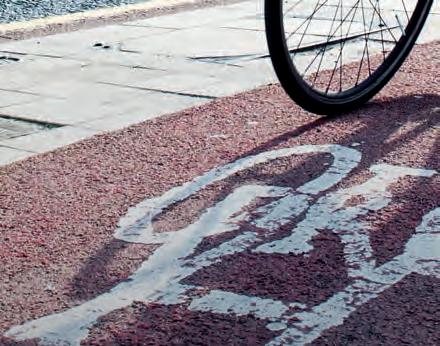



MEMBERSHIP FROM JUST £3. 88 A MONTH!* CLICK HERE FOR MORE INFORMATION *See www.cyclinguk.org/join for more information and for terms and conditions. MEMBERSHIP FROM JUST £3. 88 A MONTH!* CLICK HERE FOR MORE INFORMATION
Grouptest Road bike mudguards
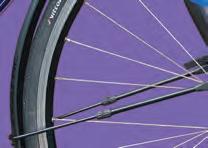
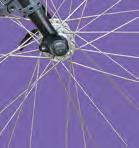
Bikes without clearance or fixings for normal mudguards can still be fitted with road-bikespecific ones. Emma Silversides tests four sets

Details WHAT TO LOOK FOR
EMMA SILVERSIDES
Since retiring from professional road racing, Emma continues to cycle daily, with touring being high on her agenda
Adecent set of guards can make for an infinitely more comfortable ride in wet conditions. They stop road spray from flicking off both wheels, keeping your feet, lower legs and back drier for longer – not to mention your kit cleaner. Your frame, components and drinks bottle get protected from the grit, salt and pollutants that sit in standing surface water. Last but not least, they save the kit and eyes of the person riding behind you if you venture out with groups.
While some folk are lucky enough to have dedicated winter bikes with conventional guards, others rely on temporary measures for a single bike that they use all year round. However, an increasing number of modern road bikes don’t have sufficient clearance or fixings for guards. Designs of ‘quickrelease’ options have improved hugely to match the rise in minimal-clearance, race-orientated bikes.
All the guards I’ve tested are designed to go on and off quickly, so taking them off for dry days, as well as bike cleaning or fettling, should be a twominute job – likewise putting them back on.
Cycle’s test promise
At Cycle, we are proudly independent. There’s no pressure to please advertisers as we’re funded by your membership. Our product reviews aren’t press releases; they’re written by experienced cyclists after thorough testing.
1 Coverage
A guard offering generous coverage will protect you, your bike and riders behind. Some extend in front of the brakes, while others offer nothing at all here. If you ride alone, you can get away with something shorter at the rear.
2 Fixings

Are you willing to use straps/bands/ adhesive strips directly on your frame? While there are some designs that don’t touch your paintwork, many attach directly to the fork and seatstays, which could compromise the frame’s finish.
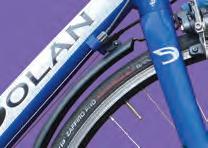


3 Stability
Guards not using eyelets are likely to have a degree of play. Incessant vibrations from rough surfaces can result in shaking, rattling and rubbing. Fine adjustments can
avoid this but if you have wider tyres it might be unavoidable.
4 Fitting
Check manufacturer websites for videos and hints. Some written instructions are vague, so watching an expert do the job can save you time and hassle. When you receive your guards, never assume that any bolts already fitted to them are secure.
5 Adjusting
Check every fixing before heading out and take necessary tools for minor adjustments. Very few guards will be perfectly fitted before your first outing. If mounting requires pads/ adhesive/straps, take spares out with you. Don’t forget to clean guards frequently to avoid a build up of dirt and debris.
CYCLINGUK.ORG cycle 69
MUDGUARDS GROUPTEST
SW England
The West Country Way


Jane John and three friends went bikepacking from the English Channel to the Bristol Channel


Last year we cycled King Alfred’s Way on our mountain bikes in a heatwave and, surprisingly, absolutely loved it. This year’s challenge was the West Country Way: 130 miles and 13,800ft of climbing from Plymouth to Minehead over three days, again in a heatwave. It didn’t start well. One husband got stuck on the very crowded Plymouth train helping us stow our bikes. The first stop after Reading was Taunton!
Things could only get better... and they did. Some highlights included: the early morning ride out of Plymouth on disused railway tracks; the joy of second mid-morning breakfasts and the inevitable ‘route advice’ given to us by café locals; the welcome cool of pushing our bikes through rivers in 30º heat; and the privilege of having the national parks virtually to ourselves.
We also enjoyed: the 7.30am ride along the Two Moors Way gouged into cliffs below Castle Drogo; whooping as we made it to the top of Dunkery Beacon in the mist (disturbing couples quietly picnicking – apologies); practising our herding skills on stubborn, path-blocking cows, ponies and a pig; and the many glorious downhill swoops in the Devon and


Somerset countryside, the rewards for killer climbs.
Low points included the broomcupboard-sized bike storage on the train, and the route across the very busy A361. The only sensible option we could find was lugging our mountain bikes along the boardwalks of the Two Moors Way footpath and humping them up over the trees holding up the board walk, which at least took us under the A361. We missed Cycling UK’s expert route planning!
The trip provided more memories to treasure of time spent cycling with three good friends (met through Wantage Cycling UK), who all value and support each other and who know when hysterical laughter is the only option!
Ireland bit by bit Eire
MY PARTNER ED and I decided to cycle Ireland’s Wild Atlantic Way back in 2018. It’s 2,600km (1,600 miles) up the west coast from Cork in the south to Donegal in the north, finishing in Derry/Londonderry in Northern Ireland. We estimated it would take three two-week holidays.
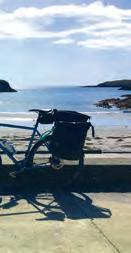


We set off in September 2018 and cycled all the headlands of Cork and Kerry, finishing in Tarbert where a ferry goes across the Shannon to Co Clare. The highlights were the tips of all the headlands, which were so beautiful and always had few cars.
The following year we set off from Tarbert Ferry and cycled all the coast of Co Clare and Co Galway, finishing in Ballina in Co Mayo. We spent an amazing night on Aranmore, one of the Aran Islands, and saw dolphins from the ferry.
Covid put paid to the next two years, so we set off to complete our challenge last summer. We had 10 days’ cycling from Mayo to Derry/Londonderry. There were occasional busy roads with no alternatives, but otherwise miles of fabulous, beautiful and sometimes very hilly roads. We stayed in B&Bs, hostels and the odd hotel. We drank many pints of Guinness and ate our weight in salmon-and-potato suppers.
Now we just need to decide whether to carry on and circumnavigate Ireland.
More online Fancy contributing to Cycle? Read the guidelines here: cyclinguk.org/be-part-cyclemagazine
TALES 74 cycle DECEMBER 2022/JANUARY 2023 Stay connected facebook.com/CyclingUK Twitter @wearecyclinguk membership@cyclinguk.org editor@cyclinguk.org
TRAVELLERS’
Sweet relief in 30ºC heat
Dunkery Beacon
The ocean is never far away
Shelagh O’Riordan rode the 1,600mile Wild Atlantic Way in stages





























 DAN JOYCE Cycle Editor
DAN JOYCE Cycle Editor


























































































